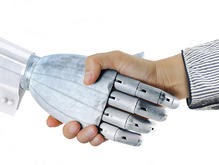- Difference between Artificial Intelligence and Machine Learning | Everything You Need to Know
- How Quantum Computing Will Transform Cybersecurity | All you need to know [ OverView ]
- What is Design Thinking? : 5 Stages in the Design Thinking Process [OverView]
- What is Design Thinking Model?
- The Top 5 Technology Trend Creators | All you need to know [ OverView ]
- AI vs Data Science: Mapping Your Career Path [ Job & Future ]
- What is Computer Vision & How does it Works ? : Everything You Need to Know [ OverView ]
- What is TensorFlow? : Expert’s Top Picks | Everything You Need to Know
- Keras vs Tensorflow vs Pytorch | Difference You Should Know
- Advantages and Disadvantages of Artificial Intelligence
- What are the Deep Learning Algorithms You Should Know About?
- The Rise of Artificial Intelligence and Machine Learning Job Trends
- Top 5 Jobs In AI and Key Skills Needed To Help You Land One
- Top AI and Machine Learning Trends for 2020
- How to Build a Career in AI and Machine Learning?
- Artificial Intelligence for Beginners
- What Is Emotional Intelligence and Its Importance?
- What Is Artificial Neural Networks?
- Top Real World Artificial Intelligence Applications
- What is Artificial Intelligence?
- Difference between Artificial Intelligence and Machine Learning | Everything You Need to Know
- How Quantum Computing Will Transform Cybersecurity | All you need to know [ OverView ]
- What is Design Thinking? : 5 Stages in the Design Thinking Process [OverView]
- What is Design Thinking Model?
- The Top 5 Technology Trend Creators | All you need to know [ OverView ]
- AI vs Data Science: Mapping Your Career Path [ Job & Future ]
- What is Computer Vision & How does it Works ? : Everything You Need to Know [ OverView ]
- What is TensorFlow? : Expert’s Top Picks | Everything You Need to Know
- Keras vs Tensorflow vs Pytorch | Difference You Should Know
- Advantages and Disadvantages of Artificial Intelligence
- What are the Deep Learning Algorithms You Should Know About?
- The Rise of Artificial Intelligence and Machine Learning Job Trends
- Top 5 Jobs In AI and Key Skills Needed To Help You Land One
- Top AI and Machine Learning Trends for 2020
- How to Build a Career in AI and Machine Learning?
- Artificial Intelligence for Beginners
- What Is Emotional Intelligence and Its Importance?
- What Is Artificial Neural Networks?
- Top Real World Artificial Intelligence Applications
- What is Artificial Intelligence?

What is Artificial Intelligence?
Last updated on 25th Sep 2020, Artciles, Artificial Intelligence, Blog
WHAT IS ARTIFICIAL INTELLIGENCE (AI)?
It depends who you ask.
Back in the 1950s, the fathers of the field Minsky and McCarthy, described artificial intelligence as any task performed by a program or a machine that, if a human carried out the same activity, we would say the human had to apply intelligence to accomplish the task.
That obviously is a fairly broad definition, which is why you will sometimes see arguments over whether something is truly AI or not.
AI systems will typically demonstrate at least some of the following behaviours associated with human intelligence: planning, learning, reasoning, problem solving, knowledge representation, perception, motion, and manipulation and, to a lesser extent, social intelligence and creativity.
Subscribe For Free Demo
Error: Contact form not found.
SPECIAL FEATURE

Special Feature: Managing AI and ML in the Enterprise
WHAT ARE THE USES FOR AI?
AI is ubiquitous today, used to recommend what you should buy next online, to understand what you say to virtual assistants such as Amazon’s Alexa and Apple’s Siri, to recognise who and what is in a photo, to spot spam, or detect credit card fraud.
WHAT ARE THE DIFFERENT TYPES OF AI?
At a very high level artificial intelligence can be split into two broad types: narrow AI and general AI.
Narrow AI is what we see all around us in computers today: intelligent systems that have been taught or learned how to carry out specific tasks without being explicitly programmed how to do so.
This type of machine intelligence is evident in the speech and language recognition of the Siri virtual assistant on the Apple iPhone, in the vision-recognition systems on self-driving cars, in the recommendation engines that suggest products you might like based on what you bought in the past. Unlike humans, these systems can only learn or be taught how to do specific tasks, which is why they are called narrow AI.
WHAT CAN NARROW AI DO?
There are a vast number of emerging applications for narrow AI: interpreting video feeds from drones carrying out visual inspections of infrastructure such as oil pipelines, organizing personal and business calendars, responding to simple customer-service queries, co-ordinating with other intelligent systems to carry out tasks like booking a hotel at a suitable time and location, helping radiologists to spot potential tumors in X-rays, flagging inappropriate content online, detecting wear and tear in elevators from data gathered by IoT devices, the list goes on and on.
WHAT CAN GENERAL AI DO?
Artificial general intelligence is very different, and is the type of adaptable intellect found in humans, a flexible form of intelligence capable of learning how to carry out vastly different tasks, anything from haircutting to building spreadsheets, or to reason about a wide variety of topics based on its accumulated experience. This is the sort of AI more commonly seen in movies, the likes of HAL in 2001 or Skynet in The Terminator, but which doesn’t exist today and AI experts are fiercely divided over how soon it will become a reality.
A survey conducted among four groups of experts in 2012/13 by AI researchers Vincent C Müller and philosopher Nick Bostrom reported a 50 percent chance that Artificial General Intelligence (AGI) would be developed between 2040 and 2050, rising to 90 percent by 2075. The group went even further, predicting that so-called ‘ superintelligence’ — which Bostrom defines as “any intellect that greatly exceeds the cognitive performance of humans in virtually all domains of interest” — was expected some 30 years after the achievement of AGI.
That said, some AI experts believe such projections are wildly optimistic given our limited understanding of the human brain, and believe that AGI is still centuries away.

Artificial intelligence:
AI might be a hot topic but you’ll still need to justify those projects.
WHAT IS MACHINE LEARNING?
There is a broad body of research in AI, much of which feeds into and complements each other.
Currently enjoying something of a resurgence, machine learning is where a computer system is fed large amounts of data, which it then uses to learn how to carry out a specific task, such as understanding speech or captioning a photograph.
WHAT ARE NEURAL NETWORKS?
Key to the process of machine learning are neural networks. These are brain-inspired networks of interconnected layers of algorithms, called neurons, that feed data into each other, and which can be trained to carry out specific tasks by modifying the importance attributed to input data as it passes between the layers. During training of these neural networks, the weights attached to different inputs will continue to be varied until the output from the neural network is very close to what is desired, at which point the network will have ‘learned’ how to carry out a particular task.
A subset of machine learning is deep learning, where neural networks are expanded into sprawling networks with a huge number of layers that are trained using massive amounts of data. It is these deep neural networks that have fuelled the current leap forward in the ability of computers to carry out tasks like speech recognition and computer vision.
Understanding Artificial Intelligence
When most people hear the term artificial intelligence, the first thing they usually think of is robots. That’s because big-budget films and novels weave stories about human-like machines that wreak havoc on Earth. But nothing could be further from the truth.
Artificial intelligence is based on the principle that human intelligence can be defined in a way that a machine can easily mimic it and execute tasks, from the most simple to those that are even more complex. The goals of artificial intelligence include learning, reasoning, and perception.
As technology advances, previous benchmarks that defined artificial intelligence become outdated. For example, machines that calculate basic functions or recognize text through optical character recognition are no longer considered to embody artificial intelligence, since this function is now taken for granted as an inherent computer function.
AI is continuously evolving to benefit many different industries. Machines are wired using a cross-disciplinary approach based in mathematics, computer science, linguistics, psychology, and more.
Applications of Artificial Intelligence
The applications for artificial intelligence are endless. The technology can be applied to many different sectors and industries. AI is being tested and used in the healthcare industry for dosing drugs and different treatment in patients, and for surgical procedures in the operating room.
Other examples of machines with artificial intelligence include computers that play chess and self-driving cars. Each of these machines must weigh the consequences of any action they take, as each action will impact the end result. In chess, the end result is winning the game. For self-driving cars, the computer system must account for all external data and compute it to act in a way that prevents a collision.
Artificial intelligence also has applications in the financial industry, where it is used to detect and flag activity in banking and finance such as unusual debit card usage and large account deposits—all of which help a bank’s fraud department. Applications for AI are also being used to help streamline and make trading easier. This is done by making supply, demand, and pricing of securities easier to estimate.
